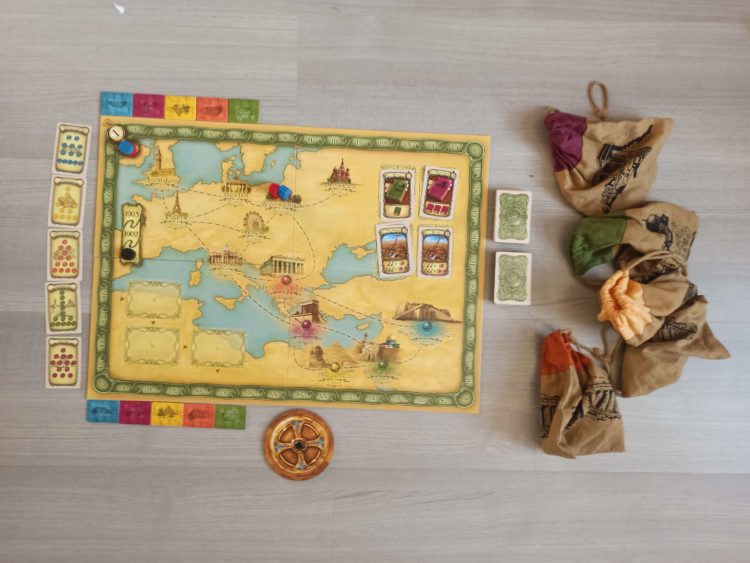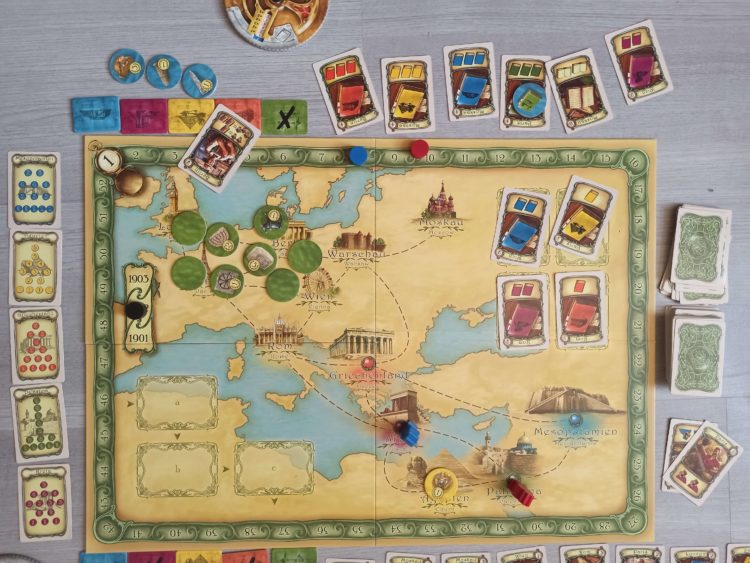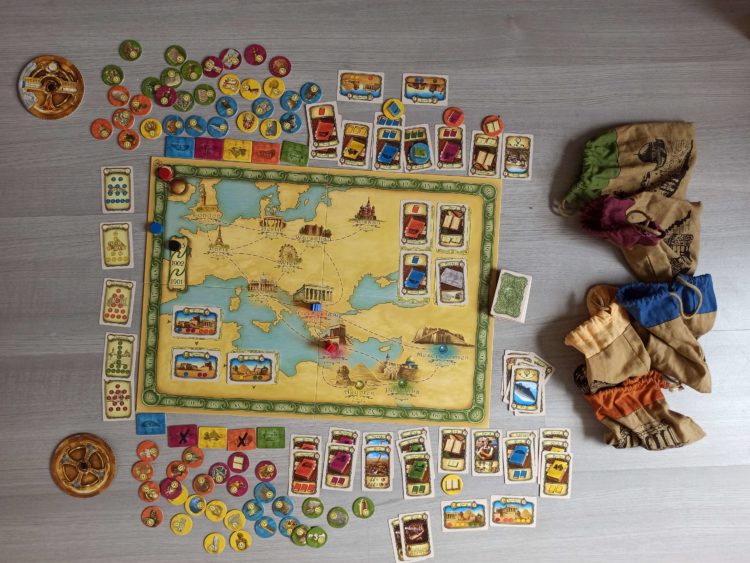
OBJECTIVE OF THEBES: The objective of Thebes is to become the most prestigious archaeologist by conducting excavations.
NUMBER OF PLAYERS: 2 to 6
MATERIALS:
- 1 rule book and
- 1 summary sheet
- 1 game board – with 12 places (7 cities in Europe and 5 excavation sites in the area of the Mediterranean) connected by a transportation network
- 4 archaeologist pawns, in the 4 player colours
- 4 time markers, in the 4 player colours
- 1 year marker
- 85 researcher cards, including knowledge cards, various support cards, and 9 congress cards
- 10 exhibition cards, 5 small exhibitions worth 4 victory points and 5 large exhibitions worth 5 victory points.
- 5 summary cards showing the layout of each excavation site
- 4 time wheels, in the 4 player colours: each consists of two disks and two plastic rivets.
- 4 sets of excavation permissions, 1 for each player for each area (1 set = 5 permissions)
- 155 excavation tokens, each excavation area having
- 15 items to find: 13 artefacts, 1 specialized knowledge item for another excavation area and 1 general knowledge item.
- 16 worthless debris tokens.
- 5 cloth bags with coloured tops, one for each excavation area
TYPE OF GAME: timed actions archaeology game
AUDIENCE: teen, adult
OVERVIEW OF THEBES
Thebes places the players in the shoes of an archaeologist in the beginning of the twentieth century. To become the most prestigious archaeologist, they have to gather knowledge by studying in major European cities before going on excavation missions and – hopefully – discovering valuable artefacts to expose in prestigious exhibitions.
SETUP
Each player takes:
- The archaeologist’s pawn, the time marker and the time wheel in its own colour.
- places his/her archaeologist pawn on Warschau.
- places his time marker on the start square of the time track (on square 16 if there are 3 players )
- One excavation permission per area, which he places in front of him on their valid side.
Preparing the game board:
- The year marker is placed on the 1902 square for 4 players, otherwise on 1901.
- An artefact token of value 1 is placed on the excavation area of the same colour. The other artefact tokens go into the bag of the same colour, with the other tokens of that colour.
- The 5 cards describing the values of the artefact tokens are placed near the board.
Preparing the cards:
- Set aside the 10 Exhibition cards.
- Place 4 researcher cards face up on the game board in the spaces provided.
- Separate the remaining researcher cards into 3 piles.
- With 2 players, mix the 10 exhibitions in pile n°2.
- With 3 and 4 players, mix the 5 small exhibits in pile n°2, and the 5 large ones in pile n°3.
- Place pile n°1 on pile n°2 to form the draw pile. Set pile n°3 aside.

GAMEPLAY
The turn order is determined by the time track. Each action made by the players costs a certain amount of time, counted in weeks on the time track. Thus the game turn is to the player who is last on the time track. If two players are on the same square, the player with his marker on top is considered to be last (and therefore plays before).
During his turn, a player can perform one of the four available actions:
- buy a researcher card
- replace researcher cards
- perform excavations
- perform an exhibition
Most of the time, the action performed will require moving the player’s pawn to the place where the action is performed. The rules for moving are as follows:
- 1 trip between two adjacent locations counts as 1 week
- Several pawns may occupy the same place, the last pawn to arrive lands on the other(s).
- The Auto card allows you to reduce by one week the duration of a journey of at least 3 weeks.
- The Zeppelin card allows you to make any trip in zero weeks instead of the normal duration, but is for single use only (discard the card after use).
- When a player’s pawn exceeds week 52, that player flips all his search permissions on their valid side.
- When all of the players’ pawns have changed years, move the Year marker to the next Year square.
- In the year 1903, players are not allowed to make any action that would cause them to pass square 1.
1. Buying a researcher card
After moving his pawn to the location indicated on the purchased card, the player must also spend a certain amount of time, also indicated on the card, to acquire it (and the associated knowledge). He then places the card face up in front of him, and draws one to fill the empty space on the game board.
2. Replacing researcher cards
After moving his pawn to Warschau, the player spends 1 week to discard the 4 researcher cards on the board, and draws to replace them. If a player makes this action several times before the next player’s turn, the cost increases by 1 week each time.
3. Performing an excavation
In order to search a place, the following conditions must be met by the player:
- Move his pawn to the place he wishes to excavate
- Have a valid permission (the Special Permission card allows 1 invalid search, then must be discarded).
- Have at least one point of specialized knowledge in front of him. These points can be brought by
- Closed books of the colour of the place searched (for permanent use): 1 point per book
- Local characters of the colour of the place searched (single use, dsicard after use): 1 point per character
- Assistants (permanent use): 2 assistants bring 1 point, 3 assistants bring 2 points; 1 assistant alone may be discarded to bring 1 point.
- the number of general knowledge (open book) must not exceed that of specialized knowledge
Set the timer to the total number of knowledge used. Choose the number of weeks spent searching, then pick in the bag the number of tokens shown in red. This number can be increased using the player’s Shovel cards (permanent use): 2 shovels bring 1 token, 3 shovels bring 2 tokens (1 shovel used alone can be discarded to bring 1 token).
After the search:
- Put the empty tokens back in the bag.
- Put others in front of you.
- If it was the first excavation made in the area, take the token of value 1 placed on the area.
- Flip your permission on its crossed face (invalid permission).
4. Performing an exhibition
After moving his pawn to the exhibition city, the player must check that he has the required artifact tokens (indicated on the Exhibition card) and then spend the time indicated on the card. He can then take the Exhibition card and place it face up in front of him.

Drawing an exhibition card
Whenever an exhibition is drawn, place it on square a, and draw another card. Shift the exhibitions already present: a to b, b to c, c tothe discard pile. The first time the draw pile is exhausted, shuffle the pile set aside at the beginning of the game with the discard pile to reconstitute the draw pile. The next times, simply shuffle the discard pile to reconstitute the draw pile.
END OF GAME
At the end of 1903, use the time track to count the points:
- 1 to 7 points per artefact (indicated on their token)
- 4 to 5 points per exhibition
- 0 to 28 points depending on the number of Congress cards of the player
- 5 points to a player having the majority in specialized knowledge of a colour (closed books), or 3 points if several players have the majority.
The player with the most points wins.

Enjoy! 😊
- Comprehensive Guide to the Board Game Go (weiqi, baduk) - January 23, 2024
- Are Creative Suites Changing Gaming - October 30, 2023
- How Classic Games Have Been Reimagined for Modern Audiences - October 5, 2023